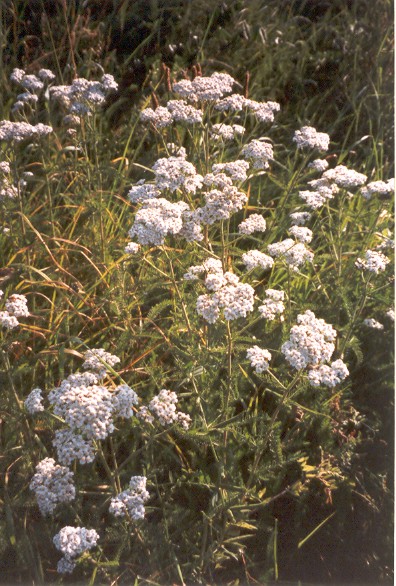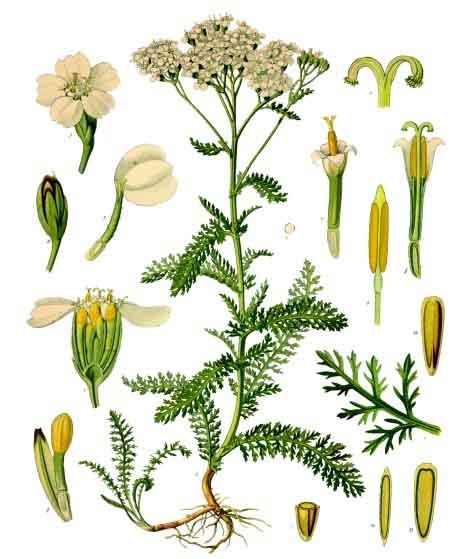Achillea millefolium (L)
Synonyms and Common names: Milfoil, Millefoil, Nosebleed, Staunchgrass, Thousand-leaf, Soldier's woundwort, Sanguinary, Bloodwort, Noble yarrow, Old Man's Pepper, Knight's Milfoil, Herbe Militaris, Thousand Weed, Carpenter's Weed, Staunchweed, Devil's Nettle, Devil's Plaything, Bad Man's Plaything, Yarroway, Angel flower
French = Millefieulle, achillee, German = Schafgarbe, Italian = mille foglio
Order: Compositae

Description: A native perennial upright, aromatic herb, with tough, erect, furrowed woody stems up to 50cm high, growing from a creeping rhizome. The finely-divided alternate leaves are 5-12cm long, bi- and tri-pinnate, accounting for its Latin name meaning 'thousand-leaf'. The composite flowers are arranged in dense flat-topped terminal corymbs, white to pink, each flower being about 4-6mm in diameter and with a characteristic odour. It is common in pastures, grassy banks, hedgerows and waste places in dry sunny positions throughout most of Europe, but is rare in the Mediterranean. Plants with only white flowers grow on calcium-rich soils, but pink-flowered yarrow may grow on acid soils. Plants grown on acid soils contain greater quantities of the active constituent azulene.
Parts used: dried aerial parts, essential oil
Collection: during the flowering period, between June and September. The leaves may be collected throughout the growing season.
Constituents: Up to 0.5% volatile oil (containing up to 51% of the blue oil azulene, borneol, terpineol, isoartemisia ketone, cineol, eugenol, thujone, pinene, camphor, achillin, sabinene), lactones, cyanogenic glycosides, aconitic and isovalerianic acid, salicylic acid, asparagin, triterpenes, sterols, flavonoids (apigenin, rutin, luteolin, quercetin, kaempferol), bitters (including ivain), tannins, hydroxycoumarins, saponins, sugars, cyanidin, amino acids, fatty acids, glycoalkaloid (achilleine), resins, fluorescent substance.
Actions: Diaphoretic, antipyretic, hypotensive, peripheral vasodilator, astringent, haemostatic, diuretic, urinary antiseptic, anti-inflammatory, spasmolytic, aromatic bitter, digestive stimulant, emmenagogue, restorative and regulator for menstrual system. The essential oil is anti-inflammatory, anti-allergenic and antispasmodic.
Indications: Fevers, common cold, essential hypertension, digestive complaints, loss of appetite, amenorrhoea, dysentery, diarrhoea. Specifically indicated in thrombotic conditions with hypertension, including cerebral and coronary thromboses. Used topically for slow-healing wounds and skin inflammations.
Therapeutics and Pharmacology: Achillea is a
valuable diaphoretic herb
and is the central ingredient in any fever-management programme. It prevents the body
temperature from rising too high but has a minimal suppressant effect on the course of the
fever. 
The flowers are rich in chemicals that are converted by steam distillation into anti-allergenic compounds, of use in the treatment of allergic catarrhal problems such as hayfever. The dark blue essential oil, azulene, is generally used as an anti-inflammatory, or in chest rubs for colds and influenza.
Achillea lowers high blood pressure by dilating the peripheral vessels, and it also tones the blood vessels. It is considered to be a specific in thrombotic conditions associated with high blood pressure. Used externally, its astringent properties will aid in the healing of wounds, and it has been used to treat haemorrhoids and varicose veins. The leaves encourage blood clotting, so can be used fresh for nosebleeds. However, inserting a leaf in the nostril may also start a nosebleed. Achillea has also been used in the treatment of heavy and painful periods, and the presence of steroidal constituents may help to explain this activity.
The spasmolytic action of Achillea is attributed to its flavonoid content. The flavonoids help to dilate the peripheral arteries and are also believed to help clear blood clots. The flavonoid apigenin is anti-inflammatory, spasmolytic and anti-platelet; salicylic acid is anti-inflammatory, as is azulene, which also stimulates the formation of granulation tissue in wound healing. The volatile oil eugenol has local anaesthetic activity, while cineol has antiseptic and expectorant properties. The alkaloid achilleine has been shown to be haemostatic, reducing clotting time without toxic side-effects. It has also been reported to lower blood pressure. Cyanidin is anti-inflammatory and also influences the vagus nerve, slowing the heart rate. The bitter action of Achillea stimulates the digestion and the tannins have an astringent effect both internally and externally. The diuretic, expectorant and digestive stimulant action can be explained by the volatile oil content of the plant. The cyanogenic glycosides and isovalerianic acid have a sedative action and asparagin is a potent diuretic. Central nervous system depressant activity has been documented for the volatile oil, and antimicrobial properties are ascribed to the sesquiterpene lactone fraction. Moderate antibacterial activity has been documented for an ethanolic extract of Achillea against Staphylococcus aureus, Bacillus subtillus, Mycobacterium smegmatis, Escherichia coli, Shigella sonnei and Shigella flexnii.
Combinations: Achillea combines well with Sambucus and Mentha piperata as a febrifuge, perhaps with the addition of Capsicum or Zingiber; and with Tilia or Crataegus in essential hypertension. It may also be combined with Urtica and Melilotus officinalis in coronary thrombosis.
Contraindications: In rare cases, Achillea can cause severe allergic skin rashes. Prolonged use can increase the skin's photosensitivity. Large doses should be avoided in pregnancy because the herb is a uterine stimulant. Excessive doses may interfere with existing anticoagulant and hypo- or hypertensive therapies. Caution should be exercised by epileptic patients.
Preparation and Dosage (thrice daily):
Regulatory Status: GSL, Schedule 1
Dried herb: 2-4g or by infusion
Liquid Extract: 1:1 in 25% alcohol, 2-4ml
Tincture: 1:5 in 45% alcohol, 2-4ml
Pressed juice from fresh herb: 3-5ml
Additional Comments:: Achillea�s generic name is derived from the Greek hero Achilles who, during the Trojan War, reputedly used it to treat his wounds. Its specific name means �a thousand leaves� and refers to its feathery foliage. The folk name Nosebleed confirms its traditional use as an emergency styptic. The name �yarrow� is a corruption of the Anglo-Saxon name for the plant, gearwe.
Yarrow was used for love divination in the past � in Ireland young girls would cut a square sod in which grew a yarrow plant and place it beneath the pillow on their beds so that they would dream of their sweetheart. In France and Ireland it is one of the herbs of St. John, and on St. John�s Eve the Irish hang it in their homes to avert illness. It has been employed as a snuff and, in the seventeenth century, it was an ingredient of salads. n Sweden it has been used in the manufacture of beer. The peppery leaves and the flowers are used to flavour liqueurs.
The Winnebago people used a yarrow infusion to treat earache, and it was used by the early American settlers for diarrhoea, leucorrhoea, passive haemorrhage and dyspepsia. One of the plant's constituents, achilleine, was isolated and used as a quinine substitute at the turn of the century.
Yarrow stalks were used for divination purposes by the ancient Chinese; the I Ching or Book of Changes is also known as the Yarrow Stalk Oracle. In China today, yarrow is still used fresh as a poultice for healing wounds, and a decoction of the whole plant is prescribed for stomach ulcers, amenorrhoea and abscesses.
Bibliography
Bartram, T. 1995 Encyclopaedia of Herbal Medicine, 1st edn.,Grace Publishers, Bournemouth.
Bradley, P.R. (ed.) 1992 British Herbal Compendium, Volume 1, BHMA, Bournemouth.
Bremness, L. 1994 Herbs, Dorling Kindersley Eyewitness Handbook, London.
BHMA 1983 British Herbal Pharmacopoeia, BHMA, Bournemouth.
Chevallier, A. 1996 The Encyclopaedia of Medicinal Plants, Dorling Kindersley, London.
Grieve, M. 1931 A Modern Herbal, (ed. C.F. Leyel 1985), London.
Grigson, G. 1996 (2nd.edn.) The Englishman�s Flora, Helicon Publishing, Oxford.
Hoffmann, D. 1990 The New Holistic Herbal, Second Edition, Element, Shaftesbury.
Lust, J. 1990 The Herb Book, Bantam, London.
Mabey, R. (ed.) 1991 The Complete New Herbal, Penguin, London.
Mills, S.Y. 1993 The A-Z of Modern Herbalism, Diamond Books, London.
Mills, S.Y. 1993 The Essential Book of Herbal Medicine, Penguin, London (First published in 1991 as Out of the Earth, Arkana)
Newall, C.A., Anderson, L.A., & Phillipson, J.D. 1996 Herbal Medicines: A Guide for Health-care Professionals, The Pharmaceutical Press, London.
Ody, P. 1993 The Herb Society's Complete Medicinal Herbal, Dorling Kindersley, London.
Phillips, R. and Foy, N. 1990 Herbs, Pan Books, London.
Polunin, M. and Robbins, C. 1992 The Natural Pharmacy, Dorling Kindersley, London.
Press, B. & Gibbons, B. 1993 Wild Flowers of Britain and Europe: Photographic Field Guide, New Holland Publishers, London.
Prihoda, A. 1989 The Healing Powers of Nature, Octopus, London.
Rogers, S.K. 1995 British and Chinese Herbal Pharmacopoeia, Healthlink Software Systems, Australia
Vickery, R. 1995 A Dictionary of Plant Lore, Oxford University Press.
Vogel, V.J. 1970 American Indian Medicine, Volume 95 in The Civilization of the American Indian Series, University of Oklahoma Press
Weiss, R.F. 1991 Herbal Medicine, Beaconsfield Arcanum, Beaconsfield.
Wren, R.C. 1988 Potter's New Cyclopaedia of Botanical Drugs and Preparations, C.W.Daniel, Saffron Walden.











